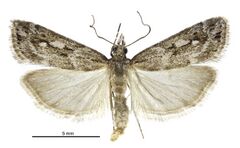Biology:Eudonia ustiramis
| Eudonia ustiramis | |
|---|---|

| |
| Female | |

| |
| Male | |
| Scientific classification | |
| Kingdom: | |
| Phylum: | |
| Class: | |
| Order: | |
| Family: | |
| Genus: | |
| Species: | E. ustiramis
|
| Binomial name | |
| Eudonia ustiramis (Meyrick, 1931)[1]
| |
| Synonyms[2] | |
| |
Eudonia ustiramis is a species of moth in the family Crambidae. This species is endemic to New Zealand. It is classified as "Data Deficient" by the Department of Conservation.
Taxonomy
This species was described by Edward Meyrick in 1931 using a specimen collected by S.C. Patterson in Whangarei in January and named Scoparia ustiramis.[3][2] George Hudson discussed and illustrated this species in his 1939 book A supplement to the butterflies and moths of New Zealand.[2][4] In 1988 John S. Dugdale assigned this species to the genus Eudonia.[2] The holotype specimen is held at the Natural History Museum, London.[2]
Description
Meyrick described the species as follows:
♂ 16 mm. Head, thorax grey mixed white. Palpi dark grey, apical edge white. Forewings elongate-triangular, termen slightly rounded, oblique; grey, costal and dorsal thirds suffusedly irrorated white; an irregular streak of black irroration beneath cell from base to end; a slenderer black streak in cell from middle to end, terminating in a white dot on angle of cell, and five rather irregular black lines on veins to termen, black dots on ends of terminal veins: cilia whitish-grey, a light grey subbasal line. Hindwings light grey; cilia pale grey, a darker subbasal shade.[3]
The wing pattern of this species is variable and the holotype has strong dark longitudinal streaks on its forewings.[5] Other specimens of this species have been confirmed through the comparison of male genitalia.[5]
Distribution
This species is endemic to New Zealand.[6][1] For many years this species was only known from its type locality.[5] However, in recent years it has been identified as a very locally common species of Northland and Auckland.[5]
Habitat
This species is known to inhabit gumland heaths.[5]
Conservation status
This species has been classified as having the "Data Deficient" conservation status under the New Zealand Threat Classification System.[7]
References
- ↑ 1.0 1.1 "Eudonia ustiramis (Meyrick, 1931)". Landcare Research New Zealand Ltd. http://www.nzor.org.nz/names/fa010449-3218-4679-8b6d-31a2da6d7133.
- ↑ 2.0 2.1 2.2 2.3 2.4 Dugdale, J. S. (1988). "Lepidoptera - annotated catalogue, and keys to family-group taxa". Fauna of New Zealand 14: 158. https://www.landcareresearch.co.nz/__data/assets/pdf_file/0017/26324/FNZ14Dugdale1988.pdf. Retrieved 27 January 2018.
- ↑ 3.0 3.1 Meyrick, E. (1931). "New species of New Zealand Lepidoptera.". Transactions and Proceedings of the Royal Society of New Zealand 62: 92–97. http://rsnz.natlib.govt.nz/volume/rsnz_62/rsnz_62_00_001380.html.
- ↑ Hudson, G. V. (1939). A supplement to the butterflies and moths of New Zealand.. Wellington: Ferguson & Osborn Ltd. p. 423. OCLC 221041540. http://www.bugz.org.nz/WebForms/ResultDetails.aspx?CurrentDoc=4A102474-EF01-4089-A31A-A1FE7E551E52&back=true&NewDoc=true&searchType=1&SearchString=Hudson. Retrieved 4 June 2018.
- ↑ 5.0 5.1 5.2 5.3 5.4 Hoare, R. J. B.; Rhode, B. E.; Emmerson, A. W. (2012). "Larger moths of New Zealand: Image gallery and online guide. : Notes on Scopariinae". https://www.landcareresearch.co.nz/resources/identification/animals/large-moths/image-gallery/pyraloid-moths/notes-on-scopariinae.
- ↑ , p. 458, Wikidata Q45922947
- ↑ Hoare, R.J.B.; Dugdale, J.S.; Edwards, E.D.; Gibbs, G.W.; Patrick, B.H.; Hitchmough, R.A.; Rolfe, J.R. (2017). "Conservation status of New Zealand butterflies and moths (Lepidoptera), 2015". New Zealand Threat Classification Series 20: 8. http://www.doc.govt.nz/Documents/science-and-technical/nztcs20entire.pdf.
External links
| Wikimedia Commons has media related to Eudonia ustiramis. |
Wikidata ☰ Q13618375 entry

